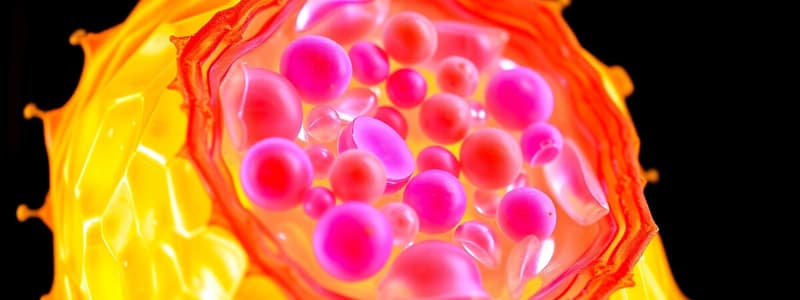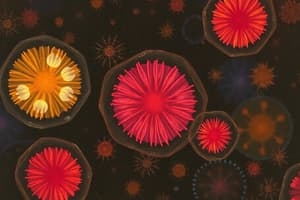Podcast
Questions and Answers
Which of the following best describes the primary role of the Golgi apparatus in eukaryotic cells?
Which of the following best describes the primary role of the Golgi apparatus in eukaryotic cells?
- Processing and packaging proteins for secretion or transport to other organelles. (correct)
- Digesting cellular waste and debris using hydrolytic enzymes.
- Generating ATP through cellular respiration.
- Synthesizing proteins from mRNA templates.
A scientist is studying a cell and observes a high concentration of polysaccharide. Which of the following is the most likely function of this polysaccharide?
A scientist is studying a cell and observes a high concentration of polysaccharide. Which of the following is the most likely function of this polysaccharide?
- Enzymatic catalysis.
- Structural component of cell membranes.
- Genetic information storage.
- Long-term energy storage. (correct)
During strenuous exercise, muscle cells may switch to anaerobic respiration. What is the primary reason why anaerobic respiration is less efficient than aerobic respiration?
During strenuous exercise, muscle cells may switch to anaerobic respiration. What is the primary reason why anaerobic respiration is less efficient than aerobic respiration?
- Anaerobic respiration does not use an electron transport chain, resulting in less ATP production. (correct)
- Anaerobic respiration occurs in the mitochondria, while aerobic respiration occurs in the cytoplasm.
- Anaerobic respiration produces water as a final product, which inhibits ATP synthase.
- Anaerobic respiration requires more glucose to start the process.
If a plant were kept in complete darkness, which process would be most immediately affected?
If a plant were kept in complete darkness, which process would be most immediately affected?
A cell is found to have a mutation that impairs its ability to synthesize lipids. Which cellular structure would most likely be affected by this mutation?
A cell is found to have a mutation that impairs its ability to synthesize lipids. Which cellular structure would most likely be affected by this mutation?
Which of the following molecules contains the genetic code?
Which of the following molecules contains the genetic code?
Which stage of cellular respiration occurs in the cytoplasm?
Which stage of cellular respiration occurs in the cytoplasm?
What characteristic is common to both prokaryotic and eukaryotic cells?
What characteristic is common to both prokaryotic and eukaryotic cells?
How do light-dependent reactions contribute to photosynthesis?
How do light-dependent reactions contribute to photosynthesis?
If a mutation occurs during DNA replication, which of the following is the most likely outcome?
If a mutation occurs during DNA replication, which of the following is the most likely outcome?
Which of the following scenarios best illustrates natural selection?
Which of the following scenarios best illustrates natural selection?
In an ecosystem, what is the primary role of decomposers in nutrient cycling?
In an ecosystem, what is the primary role of decomposers in nutrient cycling?
Which classification level contains the greatest number of different types of organisms?
Which classification level contains the greatest number of different types of organisms?
Why is maintaining homeostasis important for the human body?
Why is maintaining homeostasis important for the human body?
Which process converts DNA into RNA?
Which process converts DNA into RNA?
What does 'common descent' imply in the context of evolutionary biology?
What does 'common descent' imply in the context of evolutionary biology?
Flashcards
Cell
Cell
The basic unit of life, made of one or more cells.
Eukaryotic Cells
Eukaryotic Cells
Cells with a nucleus and membrane-bound organelles.
Prokaryotic Cells
Prokaryotic Cells
Cells that lack a nucleus and membrane-bound organelles.
Mitochondria
Mitochondria
Organelles that produce energy through cellular respiration.
Signup and view all the flashcards
Cellular Respiration
Cellular Respiration
A metabolic pathway that breaks down glucose to produce ATP.
Signup and view all the flashcards
Photosynthesis
Photosynthesis
Process where plants convert light energy into chemical energy.
Signup and view all the flashcards
Ribosomes
Ribosomes
Organelles that synthesize proteins.
Signup and view all the flashcards
Nucleic Acids
Nucleic Acids
Biomolecules like DNA and RNA that store and transmit genetic information.
Signup and view all the flashcards
Chlorophyll
Chlorophyll
A pigment that absorbs light energy for photosynthesis.
Signup and view all the flashcards
Photosynthesis Stages
Photosynthesis Stages
Occurs in two stages: light-dependent and light-independent reactions.
Signup and view all the flashcards
Mutation
Mutation
Changes in DNA sequences that can alter organism traits.
Signup and view all the flashcards
Natural Selection
Natural Selection
Mechanism of evolution where advantageous traits increase survival.
Signup and view all the flashcards
Biodiversity
Biodiversity
The variety of life forms in an area.
Signup and view all the flashcards
Homeostasis
Homeostasis
Stable internal environment maintained by body systems.
Signup and view all the flashcards
Chromosomes
Chromosomes
Structures containing DNA and proteins.
Signup and view all the flashcards
Speciation
Speciation
The formation of new species over time.
Signup and view all the flashcardsStudy Notes
Cell Structure and Function
- Cells are the basic units of life, and all living organisms are made up of one or more cells.
- Cells vary greatly in size and shape, reflecting their diverse functions.
- Key components of cells include the cell membrane, cytoplasm, and nucleus (eukaryotic cells).
- Prokaryotic cells lack a nucleus and other membrane-bound organelles.
- Eukaryotic cells contain a nucleus and various organelles, each with specific functions.
- Cell membrane controls the passage of substances into and out of the cell.
- Cytoplasm is the jelly-like substance inside the cell, containing organelles.
- Nucleus contains the cell's genetic material (DNA).
- Mitochondria are responsible for cellular respiration, producing energy.
- Ribosomes synthesize proteins.
- Endoplasmic reticulum (ER) assists in protein and lipid synthesis.
- Golgi apparatus processes and packages proteins.
- Lysosomes contain enzymes for digestion of cellular waste.
- Vacuoles store nutrients and water.
- Chloroplasts (in plant cells) conduct photosynthesis, converting light energy into chemical energy.
- Cytoskeleton provides structural support and facilitates cell movement.
Biological Molecules
- Four major classes of biological molecules: carbohydrates, lipids, proteins, and nucleic acids
- Carbohydrates are composed of carbon, hydrogen, and oxygen, and serve as an energy source.
- Simple sugars (monosaccharides) are the basic building block of carbohydrates.
- Complex carbohydrates (polysaccharides) include starch, glycogen, and cellulose.
- Lipids are composed primarily of carbon and hydrogen and insoluble in water.
- Types of lipids include fats, oils, phospholipids, and steroids.
- Proteins are composed of amino acids and perform diverse functions in the cell, such as catalyzing reactions, transport, and structural support.
- Nucleic acids, DNA and RNA, store and transmit genetic information.
Cellular Respiration
- Cellular respiration is a metabolic pathway that breaks down glucose to produce ATP.
- Aerobic respiration requires oxygen, producing a large amount of ATP.
- Anaerobic respiration occurs without oxygen, producing a smaller amount of ATP.
- Glycolysis is the first stage of cellular respiration, occurring in the cytoplasm.
- Krebs cycle (Citric acid cycle) is the second stage, occurring in the mitochondrial matrix.
- Electron transport chain is the third stage, occurring in the inner mitochondrial membrane.
Photosynthesis
- Photosynthesis is the process by which plants and some other organisms convert light energy into chemical energy.
- Chlorophyll is a pigment that absorbs light energy for photosynthesis.
- Photosynthesis occurs in two main stages: light-dependent reactions and light-independent reactions (Calvin cycle).
- Light-dependent reactions capture light energy and convert it into chemical energy.
- Light-independent reactions use the chemical energy to synthesize glucose.
Genetics
- Genes are segments of DNA that carry genetic instructions
- DNA is a double helix structure that carries genetic information.
- DNA replication is the process of making a copy of DNA.
- Transcription converts DNA into RNA.
- Translation converts RNA into proteins.
- Mutations are changes in DNA sequences, which can alter the traits of an organism.
- Chromosomes are structures that contain DNA and proteins.
Evolution
- Evolution is the change in characteristics of a species over several generations.
- Natural selection is a mechanism of evolution, where organisms with advantageous traits are more likely to survive and reproduce.
- Adaptations are traits that enhance an organism's survival and reproduction in a particular environment.
- Common descent is the concept that all life on Earth shares a common ancestor.
- Speciation is the formation of new species.
Ecology
- Ecology is the study of interactions between organisms and their environment.
- Ecosystems include biotic and abiotic factors.
- Biotic factors refer to living organisms.
- Abiotic factors refer to non-living components.
- Energy flow in an ecosystem follows the food chain or food web.
- Nutrient cycles describe the movement of nutrients through an ecosystem.
- Population dynamics concerns population size and how this changes over time.
- Biodiversity refers to the variety of life forms in an area.
Classification
- Organisms are classified into hierarchical groups (domains, kingdoms, phyla, etc.) based on shared characteristics.
- Modern classification uses evolutionary relationships as the primary basis for grouping species.
- Taxonomists use morphological and molecular data to classify organisms.
Human Biology
- Human biology studies the biology of humans.
- Anatomy and physiology relate to the structure and functions of the human body.
- Systems work together to maintain homeostasis, a stable internal environment.
- Major systems include digestive, respiratory, circulatory, nervous, and endocrine systems.
- Human reproduction involves complex processes, including gamete formation and fertilization.
- Humans show genetic variation, impacting health and predisposition to disease.
Studying That Suits You
Use AI to generate personalized quizzes and flashcards to suit your learning preferences.




